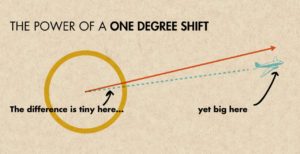One thought today:
Your daily actions are your current truth.
By the inch it’s a cinch by the mile it’s a pile.

One thought today:
Your daily actions are your current truth.
By the inch it’s a cinch by the mile it’s a pile.

Remember that small chip in your windshield that you kept putting off? It eventually spread into a major crack, costing you far more to repair than if you’d addressed it immediately. The same principle applies to your real estate business. Small, unattended issues can quickly escalate, especially in a challenging market.
Think of today’s market as a rough, pothole-filled road. If you’re not paying attention, small cracks in your business foundation can widen. For real estate agents, these cracks might look like:
These seemingly minor issues can lead to a bigger problem: the dreaded “I don’t feel like it” mentality. This feeling—this resistance to doing the work—is the universal dream killer. It stops more people from achieving their goals than any other excuse.
But you can overcome this. You can choose a different path.
Here’s a two-step strategy to overcome “I don’t feel like it” and keep your business on track:
Step 1: Acknowledge and Reframe.
It’s okay to not feel motivated sometimes. Don’t beat yourself up about it. Instead, acknowledge the feeling without letting it control you. Think of it like this: You can’t stop birds from flying over your head, but you can stop them from building a nest in your hair.
Here’s how to reframe: Instead of saying “I don’t feel like making calls today,” acknowledge the feeling (“I’m feeling a bit resistant to making calls right now”) and then add a reframe: “…but I’m going to make just five calls to get started.”
Step 2: Take One Small Action.
Momentum is built through action, not motivation. You don’t need to feel like it to start. In fact, often, the feeling of motivation comes after you’ve taken the first step.
Here are some examples of small actions you can take:
By focusing on one small, manageable action, you break the cycle of procrastination and build momentum. Once you start, you’ll often find it easier to keep going.
The Bottom Line:
You are in charge of your business, not your feelings. Don’t let “I don’t feel like it” derail your dreams. Acknowledge the feeling, reframe it, take one small action, and watch your business thrive. And that is how we win the day.
The winners are the doers.

I’ve been reflecting on some recent coaching conversations and how the concept of vectors and the “1 in 60 Rule” can apply to entrepreneurial journeys.
In mathematics and physics, a vector has both magnitude and direction. It’s a useful way to think about how a small change in direction can have a significant impact over distance. The “1 in 60 Rule,” often used in aviation, perfectly illustrates this: a one-degree error in heading translates to a one-mile deviation from the intended path after traveling 60 miles. That same one-degree error over a longer distance, like a flight from New York to Los Angeles, could mean the difference between landing at LAX and being 35 nautical miles south at SNA.
This principle resonates strongly with the entrepreneurs I work with. Often, they approach me feeling overwhelmed and burned out, grappling with a seemingly insurmountable challenge. However, more often than not, the solution isn’t a complete overhaul. It’s about identifying those small, one-degree course corrections that, compounded over time, can lead to dramatic improvements.
As Darren Hardy wisely said, “The secret of your success is found in your daily routine.” The compound effect is a powerful force, and it works both ways. Small, positive changes, consistently applied, can lead to remarkable results. Conversely, small, negative deviations can accumulate and derail even the most promising ventures.
So, the question I pose to entrepreneurs, and to anyone striving for success, is: What 1% course correction can you make today? What seemingly minor adjustment to your routine or strategy could, over time, steer you significantly closer to your goals?
Win The Day

Your prospects and clients prioritize four critical dimensions during their home-buying experience:
“There’s no shortage of remarkable ideas, what’s missing is the will to execute them.”
~Seth Godin
Let’s dig into each of these dimensions a little deeper:
Customers weigh these dimensions almost equally, with a slight edge given to reassurance.
By prioritizing these aspects, real estate sales professionals and their support teams can create a positive and memorable home-buying experience for their clients.

The Alamo: A Story of Courage and Sacrifice
As the sun sets in one place, it rises in another. But for the defenders of the Alamo, the sun never rose again. They fought bravely against overwhelming odds, knowing they would not survive. They left behind a legacy of courage and honor that inspires us to this day.
On March 6th, 1836, the 13-day siege and battle of the Alamo came to an end. The Mexican army stormed the fort and killed almost all of the defenders. Among them were famous figures like David Crockett, James Bowie, and William B. Travis, who wrote these immortal words: “I shall never surrender or retreat.” But they were not alone. About 200 other men joined them in the fight, and only 15 lived to tell the tale.
Every year, at dawn on March 6th, a ceremony commemorates the fallen heroes of the Alamo. We remember their names, their faces, and their stories. We honor their sacrifice and their spirit. Remember the Alamo.
How do you handle defeat? My strategy? Accept. Reflect, then redirect!

Ten excuses the top 1% all made, yet figured out a way to bust through:
1. I don’t have time
2. I don’t have the money
3. I will try it next year
4. I don’t have enough data
5. I am too tired, skeptical, or biased
6. No one ever did it before
7. It’s too much work
8. I could fail
9. I will wait until _____
10. It’s too risky
Bust through too…

While actions are crucial, the words we use—both to ourselves and others—have immense power. They shape our thoughts, influence our emotions, and ultimately drive our actions. Even the smallest words can have a profound impact, bringing joy or inflicting pain.
Consider the resilience of Abraham Lincoln. Over his lifetime, he faced a relentless series of setbacks: business failures, electoral defeats, personal tragedies, and even a nervous breakdown. Yet, he persevered.
Forced from his home as a child, burdened by debt after a failed business venture, and heartbroken by the loss of his fiancée, Lincoln faced adversity at every turn. He lost numerous elections, suffered a debilitating nervous breakdown, and yet, he never gave up. He ultimately rose to become President of the United States.
Imagine applying this powerful mantra to each of Lincoln’s challenges: “Because of this, something good will happen.” This simple phrase reframes adversity, suggesting that even in the darkest moments, there is potential for growth and positive outcomes.
The Power of Support:
We often hear that we can achieve anything we set our minds to, but the truth is, we rarely achieve great things alone. “You cannot change yourself by yourself.” This six-word truth highlights the importance of support and accountability. Whether it’s overcoming addiction, improving fitness, mastering a skill, or building a business, seeking guidance and support is essential. This could mean joining a support group, hiring a coach or trainer, or finding a mentor. Discipline requires accountability, and having someone to hold us accountable significantly increases our chances of success.
Conquering the “I Don’t Feel Like It” Trap:
One of the greatest dream killers is the simple phrase: “I don’t feel like it.” How often has this thought derailed your plans? The key is to recognize that feelings are not prerequisites for action. Instead of succumbing to this feeling, choose to act despite it. Replace “I don’t feel like it” with “I’ll do it anyway.”
Remember: feeling like it is not a prerequisite for doing it.
Becoming an ANTeater (Automatic Negative Thought Eater):
To conquer negative thoughts, become an “ANTeater.” This means actively challenging and reframing automatic negative thoughts. When you catch yourself thinking negatively, ask yourself:
By consistently challenging negative thoughts and choosing action over inaction, you take control of your mindset and pave the way for success. And that is how we win the day!

January will not TEXT you back… time to move on.
I was just reading a research study indicating that 95% of workers want to or plan to seek a new job in 2024! For real estate brokers, this is a two-edged sword… in one way, it opens up opportunities for recruiting and talent attraction. In another way, it’s a watch out for our own staff and agents.
My good friend and colleague Steve Murray from REALTrends did a study in the last downturn – 2008 to 2012 – and found 15 companies that grew substantially during that downturn. He found ONE common trend. It was:
“They got closer to their people. No matter how close or connected they thought they were, they were intentional about getting even closer. More connected. More relevant.”
One way is our TCF+ methodology:
What is measured improves.
For those in the program, I’d love to hear your success stories and your numbers for the week.
For those not in the program, let’s chat about what’s possible.
For all of us, 2024 is the year to Build Back Stronger. January will not TEXT you back…

Two points of view:
Either way, you get the point.

One of these is not like the other:
There is a difference between acting on the desire to “win” vs acting on the fear of “losing.”
